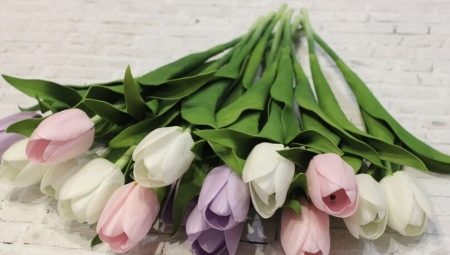A large bouquet of tulips made of foamiran will be suitable for a gift to mom, grandmother, sister, girlfriend or teacher on March 8th. Such compositions retain their original aesthetic appearance for a long time, they do not fade and do not deteriorate with short-term moisture. They look especially impressive in vases and baskets. In our review, we will give a master class that will teach you how to create beautiful tulips from foamiran with your own hands quickly and easily.

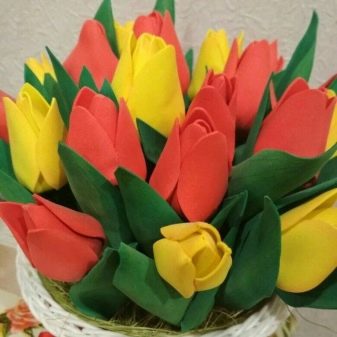
Features
Tulips are very beautiful spring flowers that are loved by many women. They symbolize love, tenderness and the onset of warm sunny days. Perhaps that is why most often they are presented on International Women's Day. They are so beautiful and bright that it is simply impossible not to love them. Even when the tulips bloom, you can always create no less spectacular flowers from foamiran if you wish.
Ready-made crafts can be a worthy decoration of the interior, and miniature flowers can always be used to create stylish jewelry - brooches or hairpins.

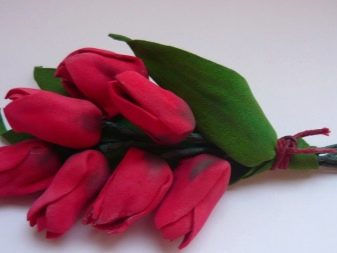
A little about the material itself. Foamiran came to us from Iran, it is a foamed ethylene vinyl acetate. On sale can be found under the name porous rubber, foam rubber, fom, as well as revolutions. Foamiran is supplied in standard sheets 50x50 cm in size, it is presented in a wide color palette. If desired, the material can additionally be mounted, giving it greater naturalness and naturalness. Foamed flowers made of revel are almost impossible to distinguish from real ones.


Tools and materials
In order to create a composition of tulips, you need to buy foamiran sheets of cream and green shades with a thickness of not more than 1 mm. In addition, you will need the following tools:
- sharp scissors;
- idle handle;
- glue "Moment", designed to work with plastic and rubber;
- glue gun;
- floristic wire;
- tape tape;
- pink wax;
- acrylic paint in white and swamp shades;
- iron with the option of switching modes.
As a decor in stores for needlework, you can buy additionally finished stamens.
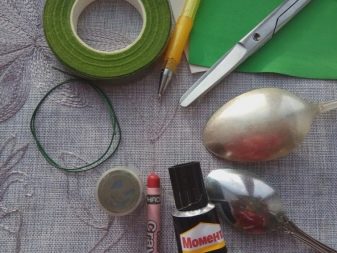
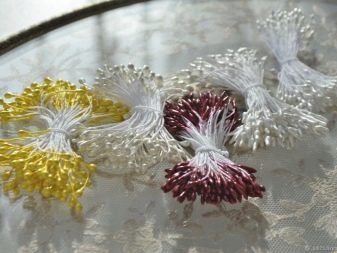
How to do it yourself?
MK for the manufacture of tulips from foamiran includes two main stages - this is the procurement of the main parts and their subsequent assembly into a single floral composition.
Harvesting parts
A step-by-step sequence of actions to create the main details of the future bouquet is as follows. To begin with, they take a plate of creamy foamiran. You can use ready-made templates for cutting, but if they are not there - it does not matter. With a handle with a non-writing rod, carefully circle the cup-shaped part of any spoon so as to exclude the stalk. To make one tulip of such petals, 6 pieces will be needed, to make the whole bouquet, make more petals.
With the help of wax crayon, the resulting workpiece is painted, while the edges must be highlighted with pressure. Further, all finished parts are cut out. On the iron set a mode designed for ironing woolen things.
We draw attention to the fact that it is advisable to first check the temperature on an extra piece of foamiran - if it deforms too much, then you need to reduce the heating level of the iron.


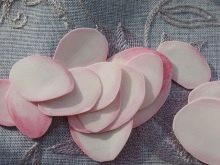
The petal is spread on the heated surface of the iron. As soon as the edges begin to bend inward, you should remove the workpiece and carefully stretch with your fingertips in the direction from a flat edge to a wide one. You must act very carefully so as not to tear the material. In addition, you have to stretch the petals twice along the side lines in order to give them the desired shape. The bend should be in the wide part.
Similarly, all blanks should be prepared.
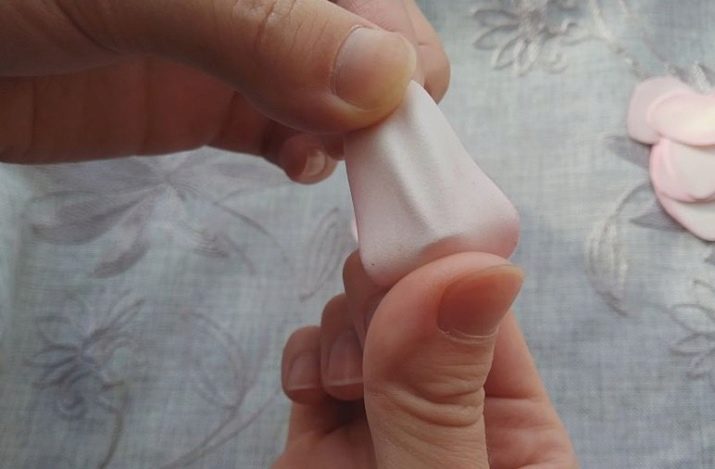
The leaves of the tulip can be cut arbitrarily - for this, the foamiran is folded 2 or 4 times, the upper part should be slightly narrower than the bottom. The blanks are ironed in the same way as the petals. Future leaves on both sides are covered with acrylic paint - it is best to do this with a sponge or just with your fingers. If the paint is too thick, you can dilute it with water.
Important: when creating petals, do not overdo it. The fact is that the foamiran is stretched only by 10%, and if you pull with effort, you will simply break it.
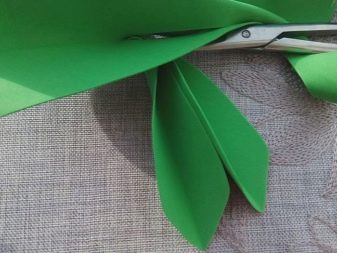
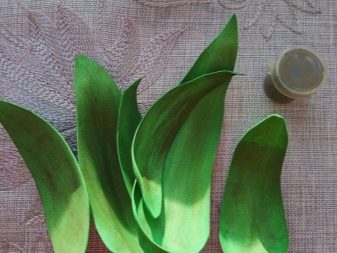
If something went wrong for you - don't be discouraged. This petal can be re-placed on the iron and once again try to sell it the desired shape.
In general, working with foamiran is very fast and pleasant. In order to make the blanks more voluminous and realistic, you can use special moldings - they apply the necessary texture to the blanks. If you don’t have such a tool at hand, you can use the usual ribbed or structured buttons, they very quickly and effectively create naturalistic veins on the leaves.
Assembly
When all the blanks are ready, you can begin to assemble the flower. To do this, a piece of floristic wire is carefully bent. After that, a circle with a diameter of 2-2.5 cm is cut out, lubricated with glue around the circumference, and foamiran scraps are inserted into the inner part for maximum volume and glued to the wire.
Next, a finger is placed on the bent end of the wire and pressed so that the rounded base of the tulip can be formed. The edge greased with glue is pressed to the stem and wait until it seizes. The core of the future tulip is carefully wrapped with teip tape to cover the edges of the foamiran.After that, they continue to wrap the wire - in this way the stem is formed. The end of the tape is fixed with glue.

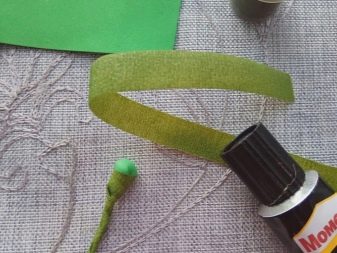
The first three petals of the base are overlapped so that their lateral edges form a triangle. Next, you need to wait a certain time specified in the instructions for the adhesive and stick another petal so that its middle part overlaps the edges of the other two. According to the same scheme, it is necessary to stick all the remaining elements.
Similarly, all tulips for a bouquet are formed. The leaves are glued, wrapping them around the green stem and placing so that each next leaf is located slightly lower than the previous one.
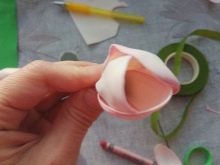
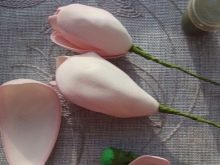
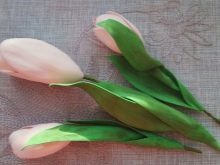
You can complete the design with a ribbon or a beautiful decorative vase.
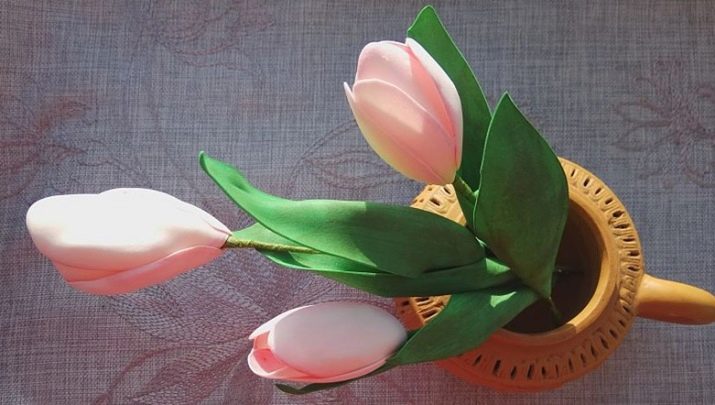
Recommendations
The technique of making bows from foamiran does not require special skills. However, much attention should be paid to the selection of a working tool. Pay attention to a few points of principle.
- Foamiran. For the first time, it is best to take a standard color - as a rule, it is green milky or white. If you wish, you can use ready-made blanks of any other colors (for example, red or yellow), but they look unnatural. It is better to give preference to the Iranian foamiran - petals of the desired shape are made of it a little easier than from Chinese material common on the domestic market. Be sure to ensure that the sheet thickness does not exceed 1 mm, since foam rubber is found in stores to create dolls or children's art - it is much wider, the flowers from it are rough.
- Glue. Most often needlewomen use small tubes of superglue, however, a hot thermogun with rods will be no less effective. Super-glue is often used in situations where you need to fix the flower "tightly", for example, stick a tulip on a brooch or rim.
- Scissors. You can use the most common, but in any case, they should be sharp.
- Iron. You can use any homemade iron to create tulips. But, as practice shows, small road models are more convenient - they are optimal for creating delicate petals and miniature details.
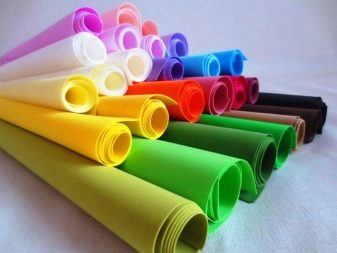
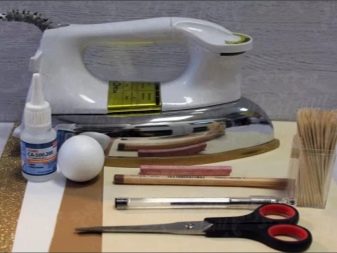
Beautiful examples
Foamiran tulips will be a great gift. Visually, they can hardly be distinguished from the real ones, with all their appearance they bring a touch of spring warmth of beauty and freshness to the interior.


- The floral arrangement in the basket looks especially impressive.

- Real decoration of the decor will be growth flowers.
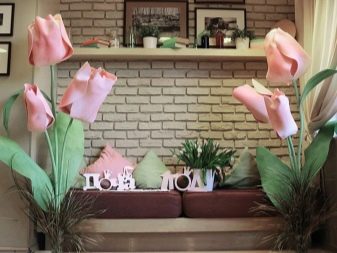

- And small tulips can be used to decorate headbands and baby erasers.

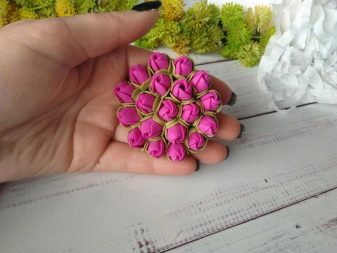
Master class on creating tulips from foamiran in the video below.
